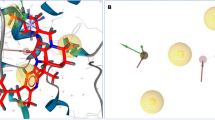Abstract
Inhibitor of apoptosis proteins (IAPs) regulate the activity of caspases in apoptosis. The human X chromosome-encoded IAP (XIAP) is one of the more potent members of the IAP family and it has been described as a central regulator of apoptosis. Thus, molecules that inhibit XIAP could offer therapeutic opportunities to treat unwanted apoptosis inhibition. In the present study we have applied the selective optimization of side activities (SOSA) approach to the discovery of XIAP inhibitors. In this sense, we have identified dequalinium hydrochloride (Dq) as an inhibitor of the XIAP/caspase-3 interaction both in vitro and in cellular assays.





Similar content being viewed by others
Abbreviations
- BIRs:
-
Baculovirus inhibitor of apoptosis proteins repeats
- Bz:
-
Benzethonium chloride
- cIAP:
-
Cellular inhibitor of apoptosis proteins 1
- Dq:
-
Dequalinium hydrochloride
- Gfa:
-
Glafenine hydrochloride
- HeLa:
-
Human epithelial carcinoma cell line
- IAP:
-
Inhibitor of apoptosis proteins
- MBz:
-
Methyl benzethonium
- MTT:
-
(3-(4,5-Dimethylthiazol-2-yl)-2,5-diphenyltetrazolium bromide)
- NMR:
-
Nuclear magnetic resonance spectroscopy
- Smac/DIABLO protein:
-
Second mitochondria-derived activator of caspases/direct IAP-binding protein with low PI
- SOSA:
-
Selective optimization of side activities
- STD:
-
Saturation transfer difference
- water-LOGSY:
-
Water-ligand observed by gradient spectroscopy
- TNF:
-
Tumor necrosis factor alpha
- XIAP:
-
X chromosome-encoded IAP
References
Birnbaum MJ, Clem RJ, Miller LK (1994) An apoptosis-inhibiting gene from a nuclear polyhedrosis virus encoding a polypeptide with Cys/His sequence motifs. J Virol 68:2521–2528
Ndubaku C, Varfolomeev E, Wang L et al (2009) Antagonism of c-IAP and XIAP proteins is required for efficient induction of cell death by small-molecule IAP antagonists. ACS Chem Biol 4:557–566
LaCasse EC, Mahoney DJ, Cheung HH, Plenchette S, Baird S, Korneluk RG (2008) IAP-targeted therapies for cancer. Oncogene 27:6252–6275
Lu M, Lin SC, Huang Y et al (2007) XIAP induces NF-kappaB activation via the BIR1/TAB 1 interaction and BIR1 dimerization. Mol Cell 26:689–702
Deveraux QL, Takahashi R, Salvesen GS, Reed JC (1997) X-linked IAP is a direct inhibitor of cell-death proteases. Nature 388:300–304
Datta R, Oki E, Endo K, Biedermann V, Ren J, Kufe D (2000) XIAP regulates DNA damage-induced apoptosis downstream of caspase-9 cleavage. J Biol Chem 275:31733–31738
Takahashi R, Deveraux Q, Tamm I et al (1998) A single BIR domain of XIAP sufficient for inhibiting caspases. J Biol Chem 273:7787–7790
Sun C, Cai M, Gunasekera AH et al (1999) NMR structure and mutagenesis of the inhibitor-of-apoptosis protein XIAP. Nature 401:818–822
Riedl SJ, Renatus M, Schwarzenbacher R et al (2001) Structural basis for the inhibition of caspase-3 by XIAP. Cell 104:791–800
Schimmer A, Dalili S, Batey RA, Riedl SJ (2006) Targeting XIAP for the treatment of malignancy. Cell Death Differ 13:179–188
Sun H, Liu L, Lu J et al (2010) Cyclopeptide Smac mimetics as antagonists of IAP proteins. Smac mimetics increase cancer cell response to chemotherapeutics in a TNF-alpha-dependent manner. Bioorg Med Chem Lett 20:3043–3046
Li L, Thomas RM, Suzuki H, De Brabander JK, Wang X, Harran PG (2004) A small molecule Smac mimic potentiates TRAIL- and TNFalpha-mediated cell death. Science 305:1471–1474
Wu TY, Wagner KW, Bursulaya B, Schultz PG, Deveraux QL (2003) Development and characterization of nonpeptidic small molecule inhibitors of the XIAP/caspase-3 interaction. Chem Biol 10:759–767
Schimmer AD, Welsh K, Pinilla C et al (2004) Small-molecule antagonists of apoptosis suppressor XIAP exhibit broad antitumor activity. Cancer Cell 5:25–35
Wermuth CG (2004) Selective optimization of side activities: another way for drug discovery. J Med Chem 47:1303–1314
Fearnhead HO (2001) Cell-free systems to study apoptosis. Methods Cell Biol 66:167–185
Garcia-Calvo M, Peterson EP, Rasper DM et al (1999) Purification and catalytic properties of human caspase family members. Cell Death Differ 6:362–369
Dalvit C, Pevarello P, Tato M, Veronesi M, Vulpetti A, Sundstrom M (2000) Identification of compounds with binding affinity to proteins via magnetization transfer from bulk water. J Biomol NMR 18:65–68
Meyer B, Peters T (2003) NMR spectroscopy techniques for screening and identifying ligand binding to protein receptors. Angew Chem Int Ed Engl 42:864–890
Pajuelo L, Calvino E, Diez JC, Boyano-Adanez MD, Gil J, Sancho P (2010) Dequalinium induces apoptosis in peripheral blood mononuclear cells isolated from human chronic lymphocytic leukemia. Investig New Drugs
Qin D, Sullivan R, Berkowitz WF, Bittman R, Rotenberg SA (2000) Inhibition of protein kinase C(alpha) by dequalinium analogues: dependence on linker length and geometry. J Med Chem 43:1413–1417
Sancho P, Galeano E, Nieto E, Delgado MD, Garcia-Perez AI (2007) Dequalinium induces cell death in human leukemia cells by early mitochondrial alterations which enhance ROS production. Leuk Res 31:969–978
Probst BL, Liu L, Ramesh V et al (2010) Smac mimetics increase cancer cell response to chemotherapeutics in a TNF-alpha-dependent manner. Cell Death Differ 17:1645–1654
Galeano E, Nieto E, Garcia-Perez AI, Delgado MD, Pinilla M, Sancho P (2005) Effects of the antitumoural dequalinium on NB4 and K562 human leukemia cell lines. Mitochondrial implication in cell death. Leuk Res 29:1201–1211
Bleday R, Weiss MJ, Salem RR, Wilson RE, Chen LB, Steele G Jr (1986) Inhibition of rat colon tumor isograft growth with dequalinium chloride. Arch Surg 121:1272–1275
Modica-Napolitano JS, Aprille JR (2001) Delocalized lipophilic cations selectively target the mitochondria of carcinoma cells. Adv Drug Deliv Rev 49:63–70
Owens TW, Foster FM, Valentijn A, Gilmore AP, Streuli CH (2010) Role for X-linked Inhibitor of apoptosis protein upstream of mitochondrial permeabilization. J Biol Chem 285:1081–1088
Acknowledgments
This work was supported by grants from the Spanish Ministry of Science and Innovation (MICINN-BIO2007-60066), Generalitat Valenciana Prometeo 2010/005 (partially funded with ERDF) and Consolider-Ingenio 2010 (MICINN-CSD2008-00005C) to E.P.-P. We thank Susana Rubio and Alicia García-Jareño for technical assistance. Y.P.-R. was supported by a postdoctoral fellowship from National Autonomous University of Mexico and Consejo Superior de Investigaciones Científicas of Spain (UNAM-CSIC).
Author information
Authors and Affiliations
Corresponding authors
Rights and permissions
About this article
Cite this article
Orzáez, M., Gortat, A., Sancho, M. et al. Characterization of dequalinium as a XIAP antagonist that targets the BIR2 domain. Apoptosis 16, 460–467 (2011). https://doi.org/10.1007/s10495-011-0582-4
Published:
Issue Date:
DOI: https://doi.org/10.1007/s10495-011-0582-4




